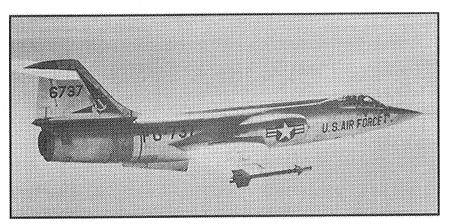Vietnam-based Việt Cộng, the other against North Vietnamese aggression.
The Air Force initially intended to destroy North Vietnam's industrial fabric and then to interdict its supplies to Viet Cong units in South
 |
The Lockheed F-104 Starfighter, above, and the Republic F-105 Thunderchief, below. Although ill-suited to it, they were pressed into limited, rather than nuclear strategic conflict in Vietnam. The Starfighter interceptor, known as "the missile with a man in it," was one of the smallest aircraft ever to serve with the USAF. It could sustain speeds above Mach 2 and held the first ever simultaneous speed and altitude records. Its wings were extremely thin and small. The powerful Thunderchief was one of the most important weapons used in the bombing of North Vietnam. Its wings were sharply swept. Modifications that allowed it to carry anti-radar missiles gave it yet another mission. |
 |
Vietnam by attacking its railroads and ocean shipping and mining its harbors. Secretary of Defense Robert McNamara and Chairman of the Joint Chiefs of Staff Maxwell Taylor vetoed the air plan, however, because it might prompt Chinese or Soviet intervention. Like that in Korea, the strategy in Vietnam was to punish the enemy until it agreed to a ceasefire and peace, not to provoke the Chinese or Soviets.


